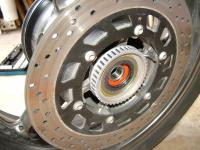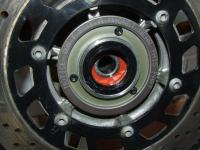mcatrophy
Privileged to ride a 2018 FJR1300AS
In preparing for a European tour next week, I got new tyres fitted. I've known that the latest years of the Gen II FJR have different wheels from earlier, but never knew what the difference was. Now I know one difference.
The ABS wheel speed sensors are different, and I thought I'd just show them in case anyone's interested.
The earlier uses a toothed disc on the wheel (picture of my '06)
(Click on image for larger view)

and presumably a coil with a magnet in the pick-up (a "variable reluctance" transducer).
The later uses a ring of what look like alternating magnets (picture of my '10):

and presumably just a coil (with a ferrous but non-magnetised core) as a pick-up.
These pictures are of the rear wheels, the fronts are similar.
No idea why Yamaha chose to change; I've not heard of any underlying problems with the older, so I can only assume it's a cost issue.
The ABS wheel speed sensors are different, and I thought I'd just show them in case anyone's interested.
The earlier uses a toothed disc on the wheel (picture of my '06)
(Click on image for larger view)

and presumably a coil with a magnet in the pick-up (a "variable reluctance" transducer).
The later uses a ring of what look like alternating magnets (picture of my '10):

and presumably just a coil (with a ferrous but non-magnetised core) as a pick-up.
These pictures are of the rear wheels, the fronts are similar.
No idea why Yamaha chose to change; I've not heard of any underlying problems with the older, so I can only assume it's a cost issue.
Last edited by a moderator:




